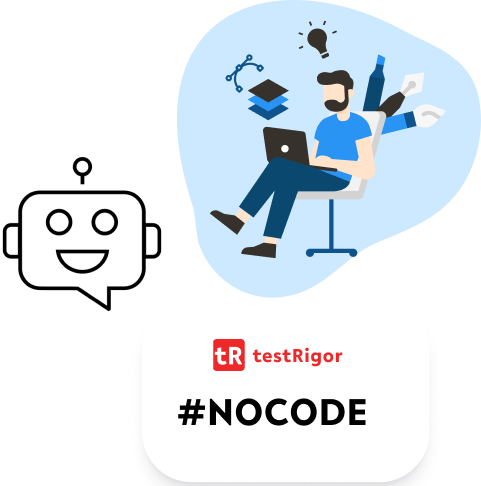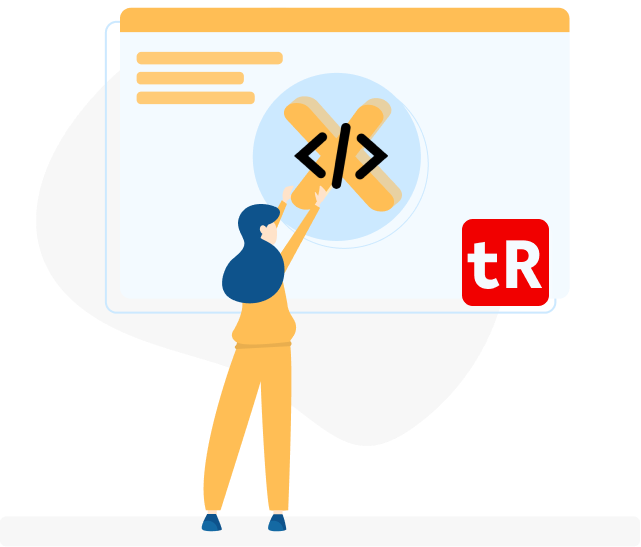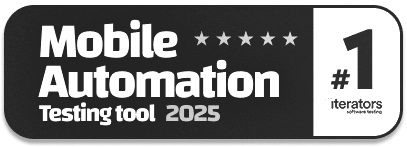Codeless Automated Testing
Low Code. No Code / Codeless.
Traditionally, functional, UI, end-to-end, etc., test automation involves writing test scripts so that testers don’t have to perform repetitive tasks manually over and over again. This job is typically done by either QA engineers or developers and requires writing a lot of code. In 2022, most companies have less functionality covered with automated tests than they desire and cite the complexity of finding the right talent as well as the slow speed of test creation as the main obstacles.
If that doesn't sound ideal to you, you're not alone. There've been many attempts to simplify an approach to test automation - and make it accessible not just to engineers but to everyone. You might've already heard of such terms as "low code," "no code," "codeless," and today, we'll dig deeper into each of these and help you form a solid understanding of them.
We'll also answer the question: does true codeless automation exist, or is it simply a marketing trick?

Codeless automation has its roots in the broader shift towards software automation that took place throughout the late 20th and early 21st centuries. In the early days of software development, almost everything was done manually, from writing code to testing. But as the scale and complexity of software systems grew, manual processes became increasingly impractical, being error-prone. The need for more efficient methods led to the development of automation tools, which could handle repetitive tasks far more quickly and accurately than humans.
However, these early automation tools often required extensive programming knowledge to use effectively, which limited their accessibility. The recognition of this limitation led to the development of codeless automation tools designed to be used by non-programmers. Codeless automation first began to emerge in the early 2010s, with simple record-and-playback tools. But the technology has advanced considerably since then, with modern codeless tools leveraging AI and machine learning to provide a much higher level of functionality and versatility.
Low Code Test Automation
No Code Test Automation

Let's start with a definition. The idea behind no-code or codeless automation is to require no prior coding experience. That means that any QA person or even any team member without an engineering background should be able to create and execute tests to validate business logic. Codeless testing sometimes also becomes the synonym of intelligent test automation - because of the extensive machine learning algorithms that might be involved in the process.
Codeless test automation tools
-
Record-and-playback tools
Where a user can simply press the record button, proceed through the test case steps, then press stop - and receive an executable test case.
Many automation tools have this feature; however, it typically results in rather messy test cases that require many optimizations to achieve readability and stability. It is also common for automation engineers to clean up and improve these test cases in the next step.
Another big disadvantage of such tools is that the test recorder is typically a browser plugin, which means you won't be able to create any cross-platform end-to-end tests this way.
-
Truly no code / codeless testing tools
Where a user can create, execute, modify and maintain any test cases entirely from scratch without prior coding knowledge. Such tools are a lot rarer than the first type; however, this should be your preferred choice if you're looking for a codeless solution. For the rest of this article, we will primarily discuss this type.


Codeless testing
No Code or codeless testing can seriously improve the quality assurance process as a whole:
- Easy support for behavior-driven development.
- Improved visibility and communication within the software team. Anyone can read the tests and make sense of the logic.
- Huge time savings, and the entire process is much more efficient. In traditional (coded) test automation, manual tests are often written first, which are converted into automated tests in the second step.
- Tests take less time to write; therefore, reaching the desired test automation coverage becomes more accessible.
There are a lot of details - and not all no-code tools are the same. We'll talk about the key points to look for in the next section.
And what about the low code automation? It allows code insertion on top of the user interface providing visual codeless automation. Some coding knowledge is a prerequisite as it offers only a portion of reusable components, while any new desirable functionality can be incorporated using low-code scripting. This means that you still need engineers to write tests (even if partially) - which is one of the significant limitations of the traditional scripted test automation.


Now that we've defined what low code automation and no code automation are, you might have a very logical question. If you have an option to pick a truly codeless tool, why settle onto something in between?
So for the sake of this article, let's focus on codeless UI automation. Remember everyone's old friend, Selenium - a powerful UI automation tool? Now, we will iterate over some data points and compare the traditional scripted Selenium approach with codeless automation.
Why Codeless Testing?
In modern software development cycles, the importance of robust testing cannot be overstated. However, traditional testing methods can introduce numerous challenges, creating bottlenecks that slow down development and deployment. This is where codeless testing emerges as a potential game-changer.

Let's delve deeper into why no-code testing can significantly enhance your software development and quality assurance processes:
- Navigating Complex Frameworks: Traditional test scripting often involves intricate framework setups. These require specific technical expertise and substantial time investment, which can divert resources away from other important aspects of product development. In contrast, codeless testing tools usually offer intuitive interfaces and automated setup procedures, making it easier and faster to get your testing environment up and running.
- Reducing Scripting Times: Writing test scripts manually can be a long, laborious process, particularly for complex applications with extensive functionality. Codeless automation, with its automated test generation capabilities, can drastically cut down scripting times. This efficiency allows teams to design and implement comprehensive test scenarios more swiftly, thereby accelerating the testing phase of the development cycle.
- Mitigating Test Code Maintenance Efforts: Code maintenance is an often overlooked but significant aspect of traditional testing. Whenever an application is updated, the test scripts need to be revised and updated accordingly, which can be a time-consuming endeavor. Codeless testing, especially tools with self-healing capabilities, can automatically adapt to application changes, thus minimizing the effort needed for test maintenance.
- Improving Productivity: All these benefits of codeless testing culminate in enhanced productivity. By reducing the technical barriers and time required for testing, both developers and testers can focus their skills and effort on their primary tasks: building and refining the product. This not only accelerates product development but also improves the quality of the product, as the team can dedicate more time to designing better features and rectifying issues.
- Doing More with Less: Today's software teams are often expected to deliver high-quality products at a fast pace, and with limited resources. This puts immense pressure on all stages of the development cycle, particularly testing. Codeless testing can alleviate this pressure by streamlining and accelerating the testing process, allowing teams to achieve more with their available resources.
- Shifting the Perspective of QA Testing: Lastly, codeless testing can transform the role and perception of quality assurance within an organization. Instead of being seen as a technical, time-consuming task that requires specialized skills, testing can become a more inclusive and integral part of the entire development process. With codeless tools, anyone on the team can create and run tests, fostering greater collaboration and shared ownership of product quality.
Industries that Benefit from Codeless Automation
While codeless automation has obvious benefits for software development and IT services, its potential applications extend far beyond these industries. Any sector that uses software systems can benefit from codeless automation.
In the healthcare industry, for instance, no-code automation can be used to streamline administrative tasks, manage patient data, and even assist with diagnostics.
In finance, this automation can speed up processes like risk assessment, compliance checking, and transaction processing. It can also help to reduce errors, a critical concern in an industry where even small mistakes can have significant financial consequences.
The education sector can use codeless automation to manage student data, automate grading systems, and streamline administrative tasks.
In manufacturing, codeless automation could assist with inventory management, quality control, and equipment maintenance.
In essence, any industry that involves repetitive, rule-based tasks could benefit from implementing no-code automation.

Test Design Overview
Designing tests is an integral part of the quality assurance process. Depending on the tools used, the process varies, but the goal remains the same: to develop a comprehensive suite of tests that validate the software's functionality under various conditions and scenarios. Let's delve deeper into the process of test design using a traditional tool like Selenium in a Behavior-Driven Development (BDD) environment, and then contrast it with the approach used in codeless automation.
Typical test designing with Selenium in a BDD (Behavior-Driven Development) includes the following:
- Page Object Model (POM) Creation: The initial step is to define a Page Object Model for every web page that's part of your test suite. The POM encapsulates the characteristics of the page, including the paths to find various web elements and the methods needed to interact with these elements for the purpose of automation. This approach abstracts the UI details and makes the tests more maintainable and less brittle.
- Test Scenario Development: After creating the POMs, the next phase involves designing the test scenarios. This typically entails the creation of page-based test steps under various scenarios and outlines. The idea is to mimic real-world usage of the application as closely as possible to ensure the software behaves as expected under different conditions.
- Script Modeling: The final phase in a traditional test design process involves scripting. Here, code corresponding to each step inside the test scenarios is written in one of the supported programming languages. The code essentially drives the interactions defined in the test scenarios using the POMs as the reference for the web elements.
On the other hand, the approach to test design is significantly different when it comes to codeless automation. The key distinction is the leveraging of advanced tools developed with Machine Learning (ML) and Artificial Intelligence (AI) technologies. These test scripts require lesser time to author, reusable for different test scenarios.
Test Maintenance
Many teams complain about automated tests being flaky - any minor change in an element under test can cause test scenarios to break. Testers find maintaining the Selenium code even more frustrating than the test design as it becomes hard to find the elements causing code to break and fix the associated impacted areas.
In general, test stability and maintenance is a very important topic, as it can quickly become a full-time job with traditional test automation. Recent developments have made this process a bit more straightforward; however, it's still a heated topic for many QA teams.
Does codeless automation solve the test maintenance issue? Not necessarily. While some no-code or low-code tools do include self-healing capabilities, this doesn't always make tests fully adaptable to radical changes. These tools are capable of learning the entire DOM structure and accommodating any changes in the background without impacting ongoing test execution. However, it's important to note that each tool has its own mechanism for achieving this. While they may sound nearly identical in description, they often include very different capabilities.

Codeless UI Testing
Let's dream, just a bit! Imagine a tool that has it all. End-to-end tests with complex logic, although without a single line of code, automatic error grouping makes maintenance a breeze, cross-platform and cross-browser support, as well as integrations with all major tools.
Such a revolutionary tool exists, and it's called testRigor. Let's look into the specifics:
- Your existing manual tests become automated ones with minimal editing. Oh, and no need to search for locators such as XPaths, ids, etc. - the extensive ML algorithms will analyze the page and do it for you. Just refer to an element how a human will see it on the screen.
- The test maintenance issue is Solved! Truly. Our existing customers share data points such as maintenance, taking up to 20x less time than they used to spend with Selenium. This was made possible with the newest technologies, which analyze a lot of data on the pages you're working with and make tests ultra-stable.
- Initial setup takes 5 minutes, and creating each test takes about the same time as writing a manual test case. Impressive, right?
Here's an example of what a simple automated test written on testRigor can look like:
login
click "Create Case"
click "Select Provider"
enter “ProviderName”
enter "Jack" into "Patient First Name"
enter "Sparrow" into "Patient Last Name"
enter "01/03/1980" into "Patient DOB"
enter "invalidEmail" into "Email Address"
check that page contains "Patient Email is not a valid email"
enter "[email protected]" into "Email Address"
check that page does not contain "PatientEmail is not valid email"
click "No" below the "Does Provider Participate with a Network?"
enter "id" into "Member ID"
enter "(0123) 456-7899" into "Insurance Phone Number"
click "Create Case"
grab value of "(?<=Number ).*$" from roughly below "CASE NUMBER" and save it as "caseName"
click "Logout"
"We spent so much time on maintenance when using Selenium, and we spend nearly 0 time with maintenance using testRigor"
Benefits of Codeless Automation
In exploring the vast array of advantages teams obtain from embracing testRigor as their preferred UI end-to-end automated testing framework, it's clear that this tool is transformative in many ways. As a cloud-based solution, it offers considerable savings in terms of both time and resources. It eliminates the need for the development and maintenance of on-premise server infrastructure, thereby reducing overhead costs and streamlining the entire testing process.
- Seamless Continuous Testing: One significant advantage of adopting testRigor is the smooth integration with the most widely used CI/CD (Continuous Integration/Continuous Deployment) tools. This integration allows for regular and consistent testing cycles, which can be scheduled to run as frequently as necessary. The continuous testing process ensures that any issues or bugs in the software are detected and addressed promptly, thereby minimizing potential disruption to the end-users. This is a crucial aspect of maintaining high-quality software products in today's fast-paced, competitive market.
- Improved Test Coverage: Utilizing testRigor's codeless automation capabilities leads to a significant increase in test coverage. The time-saving nature of automating tests with testRigor enables the creation of a larger number of test cases, thereby covering a wider range of functionalities and scenarios. This broader coverage reduces the likelihood of bugs and other issues slipping through the cracks, enhancing the overall quality and reliability of your software product.
- Enhanced Software Development Life Cycle (SDLC): Integrating codeless automation testing within your SDLC can lead to significant improvements in the development process. By providing fast, reliable feedback upon any code change, testRigor aids in identifying potential issues earlier in the development cycle. This early detection facilitates more timely problem-solving and risk mitigation, enhancing the efficiency and effectiveness of the entire SDLC.
- Superior End-to-End Tests: With the advent of testRigor, end-to-end tests have reached a new level of stability. The tests' reliability allows the team to confidently rely on them to deliver accurate, timely results. Such dependable tests can ensure a higher degree of confidence in the software's overall quality and performance. This can prove invaluable in the delivery of top-quality software products that meet or exceed user expectations.

Moreover, testRigor allows for easier collaboration and increased accessibility. Its codeless nature enables team members who may not have programming expertise to engage in the test creation and execution process, thereby fostering a more inclusive, collaborative testing environment.
The adoption of testRigor as your go-to UI end-to-end automated testing tool can have transformative effects on your team's productivity, software quality, and overall development process. These benefits demonstrate how testRigor and codeless automation, in general, are instrumental in meeting and overcoming the challenges of modern software development.
No Code Automation Testing
To get started, identify which tests to automate first - the typical approach is to start with the high-value repetitive tests, eating valuable team resources and time. Smoke and regression test suites are common to be the first automation candidates.
If you have no automation in place yet, you might choose to use testRigor's autonomous test creation feature - where the tool scans your website for most commonly used use cases and creates automated tests based on them.
You might also decide to use the included record-and-playback feature, speeding up test creation even further - which is usually the first choice of testers new to testRigor.
Alternatively, you can even hire a testRigor's QA professional who will write tests for you!


Future Outlook
As we look towards the future, we can expect codeless automation to become an increasingly important tool in the world of software development. With the growing emphasis on digital transformation, agile practices, and continuous deployment, the speed and efficiency offered by codeless automation tools are more valuable than ever.
Moreover, advances in AI and machine learning will likely lead to further improvements in codeless automation technology. We can expect future tools to be even more intuitive and powerful, capable of handling more complex tasks with less human intervention. The boundaries between coding and non-coding roles may continue to blur, as no-code tools allow more team members to participate in the automation process.
Furthermore, the rise of low-code and no-code platforms in software development could also influence our future. As these platforms become more sophisticated, they might come with built-in codeless automation features, making it even easier to implement automated testing as part of the development process.
Conclusion
With a great abundance of codeless automation benefits, companies ought to migrate faster and indulge these techniques in their agile development workflows to attain better product quality. In the meantime, testRigor's goal is to make test automation more accessible to everyone on the team and more reliable - leading to the highest quality products for your customers.











